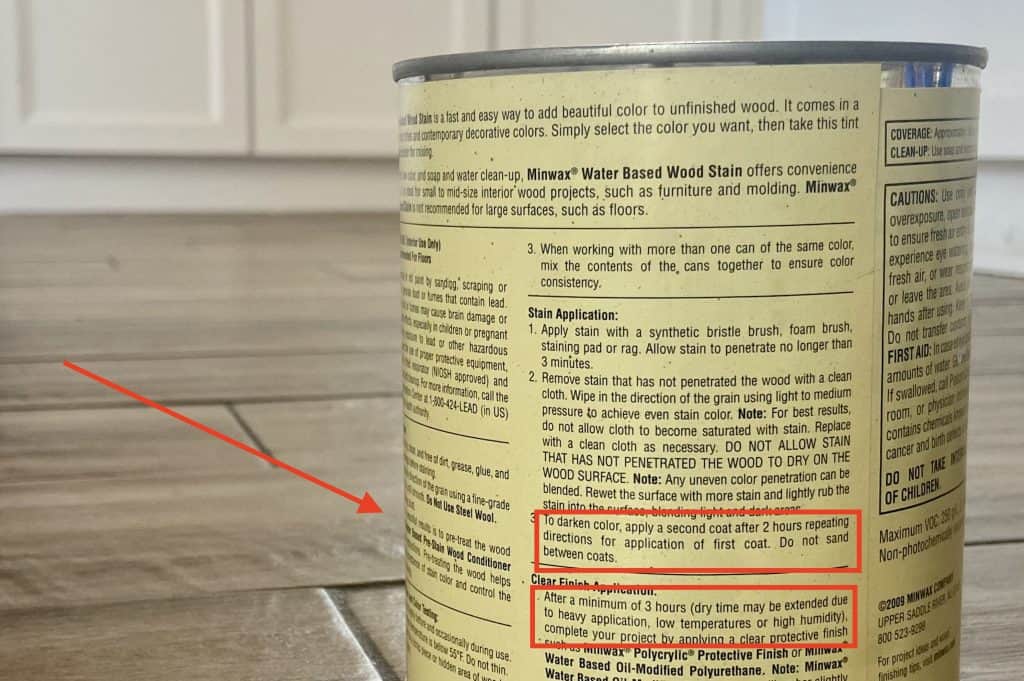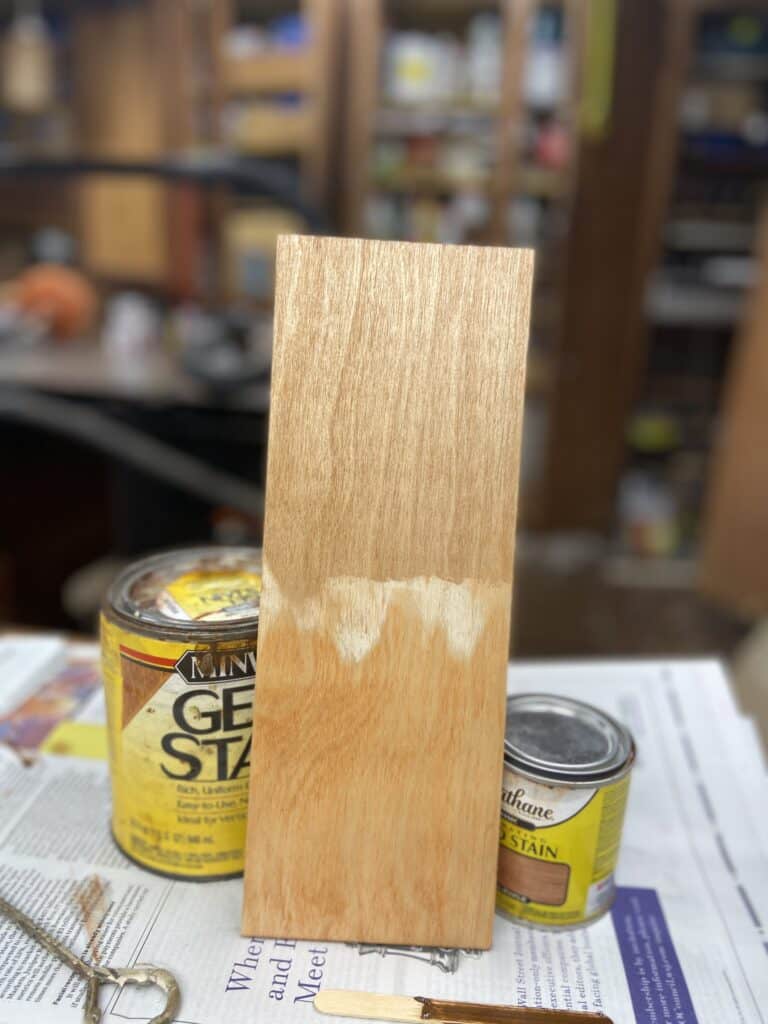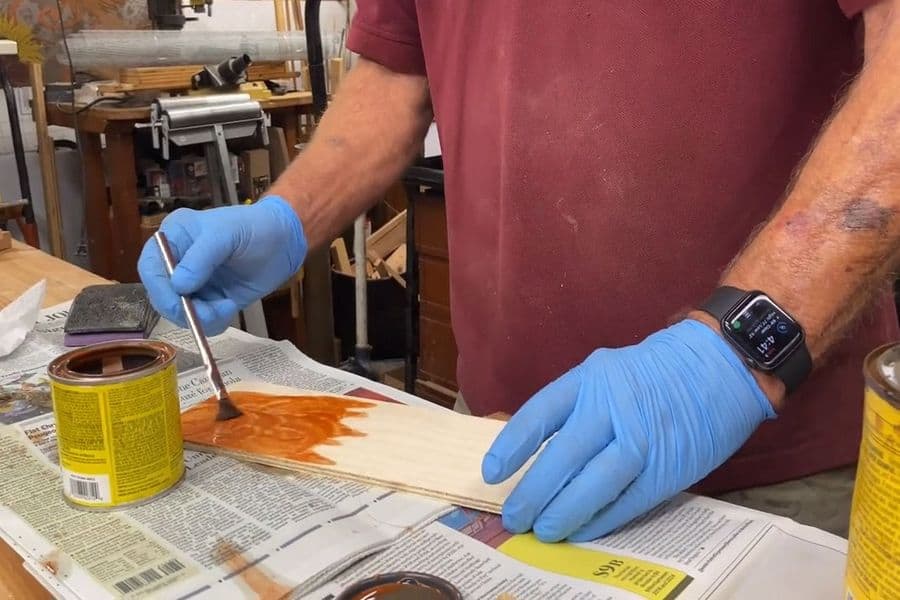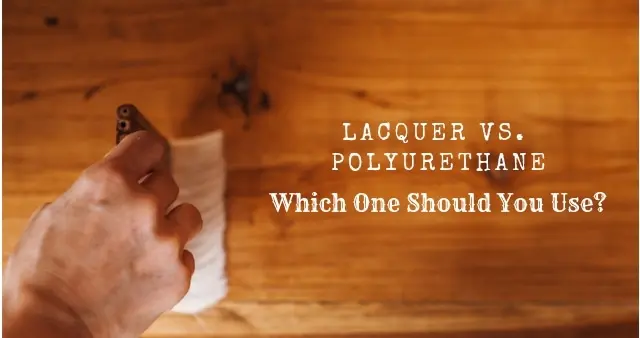Most water-based stains should be dry to the touch and ready for coating within six hours. Oil-based stains generally take 24 hours to dry. In this article, we’ll review the factors that alter the dry time of stain. By the end, you’ll be able to anticipate the total dry time for your next wood staining project.
Contents
How Long Stain Takes to Dry
Depending on the brand of stain, it can take anywhere from 1-12 hours for stain to dry.You should always let the last coat of stain dry overnight or for 24 hours before applying a topcoat or sealer.
Stain is usually considered dry when it no longer looks wet or feels tacky. If you try to sand stained wood and the sandpaper becomes gummy, the stain is not yet dry.
For higher traffic areas like flooring, you want to wait the maximum amount of time recommended for drying.
Characteristics
Stain is a tinted liquid that is brushed, wiped, or sprayed onto wood to change the color. It can be oil or water based.
The time it takes stain to dry is dependent on a number of factors. They include; the brand, the ingredients, how old it is, the atmospheric conditions and circulation during application, and whether or not it has been thinned.
Brand
Most stain containers have a portion of the label dedicated to information about dry time. Usually, this indicates how long you need to wait between coats of stain, rather than when the stain is completely dry and the wood can be used.
For example, this Minwax water-based stain claims to be fast drying, and it states:
- wait 2 hours to apply a second coat
- wait 3 hours after final coat of stain to apply a wood finisher like varnish.

If you’re applying poly, see our detailed article on how long to wait between stain and polyurethane.
Ingredients
There are two main categories of stain: oil-based, or water-based.
- Water based stains generally dry much more quickly than oil-based stains. It’s not uncommon to be able to apply a second coat of stain one hour after finishing the first coat.
- Oil-based stains tend to have dry times on the longer side. Six hours is usually the minimum amount of dry time needed for oil-based stain, with some varieties taking up to 24 hours.
Stains that include a film-forming finish harden in two phases.
- The first phase, drying, happens as the solvents included in the stain evaporate, leaving the wood surface dry to the touch.
- Curing, a polymeric hardening process, takes much longer to complete. These finishes are not fully hardened for close to a month, although they can be recoated and gently used during the curing period.
Read more about how much stain you’ll need for your project in our in-depth guide. You can also see our DIY dining table project, where we used a Minwax water based stain.
Temperature
Stain should ideally be applied at room temperature, about 70 – 75 degrees Fahrenheit.
While many stains have a wider application range, as low as 50 degrees Fahrenheit or as high as 90 degrees Fahrenheit, the further away it gets from room temperature, the more affected the dry time will be.
Stain applied in cold weather dries more slowly. Stain applied in the heat dries more quickly.

Humidity
The moisture content of the air also affects the dry time of stains. When the air is full of moisture, it has limited ability to absorb evaporating solvents. A climate-controlled environment will help ensure that the estimate on the label is accurate.
If it is too humid, the stain won’t dry until the humidity decreases. For best results, only apply stain when the humidity is 70% or less. If this isn’t realistic for your geographical location, consider running a dehumidifier and keeping your stain project indoors.
Age
Stains are usually not labeled with a sell-by, best-by, or use-by date. If you buy stain without a specific project in mind, it’s a good idea to write the date of purchase on the lid with a permanent marker.
Stain should be stored in a cool, dry environment. Unopened, it can sit on the shelf for at least three years without separating or going bad.
Exposure to air or moisture shortens the shelf life of stain. Extreme temperatures, especially those below freezing, also decrease the longevity of stain.
You can tell that stain has gone bad if you open the can and a foul, skunk-like odor escapes. If you see any mold, the stain is compromised and needs to be safely discarded. Old stain tends to separate, becoming stringy, gloppy, rubbery, or thick. You should not use stain that has any of these qualities.
Old stain will not dry. It becomes tacky, but will never fully set. If you have unopened stain that looks and smells fine, test it before use by placing a few drops on a scrap piece of plastic or glass. Rest the test piece at a 45-degree angle.
Water-based stain should dry in less than six hours. After 24 hours, oil-based stain should be dry. If the stain is still wet after this time period elapses, it has gone bad and should not be used.
You can also test the stain on a piece of cheap plywood to get a better feel for how it dries.
If you accidentally apply old stain, use naphtha or mineral spirits and a rag to remove the sticky excess. Consider stripping the wood or sanding down to bare wood before re-staining with fresh stain.
Circulation
As air moves over a stained wood surface, it encourages evaporation of the solvents and permits the stain to bond with the wood. Keeping windows open to encourage cross-ventilation is a good idea, as is running one or more fans in the workshop.

Keep in mind that high-powered fans may also blow dirt and insects into the sticky stain as it dries. If you sand between coats and clean the surface with a tack cloth, this is a non-issue, but when you get to the final coat it’s probably best to leave the fans on low or turn them off entirely.
Viscosity
Water-based stain can be diluted with water. Oil-based stains respond to a variety of thinners and solvents depending on their make-up. Mineral spirits, paint thinner, lacquer thinner, and naphtha are some of the most common products used to thin stain.
Thinned stain dries noticeably faster than unthinned stain, but it builds color slowly, and usually requires more coats. Thus, thinning stain does not usually shorten the total time of the project.
How To Speed Dry Time Of Stain
When you need to finish a project quickly, there are a few steps you can take to encourage stain to dry.
- Use water-based stains. Oil-based stains take longer to dry. They are also less pleasant to apply indoors, because of the pungent aroma. Water-based stains are lower in odor, release fewer volatile organic compounds (VOCs), and dry up to four times faster than oil-based stain.
- Choose a quick drying-stain. Read the labels in the store and choose a stain variety that can be quickly recoated as you apply.
- Control the climate. Only stain outdoors when the weather is optimal — around 70 degrees Fahrenheit and less than 70% humidity. Inside, run a heater during the application and drying process on cold days, or use an air conditioning unit in hot weather. A dehumidifier makes it possible for stain to dry even when the ambient moisture in the air is above 70%.
- Use fans strategically. Because fans can blow debris into your stain, it’s usually best to leave them off while the final coat is drying. For every previous coat, running a fan across the surface of your workpiece will noticeably decrease the amount of time you have to wait
- Thin your stain. As discussed above, thinned stain usually requires more coats to achieve the same depth of color as unthinned stain. However, if you’re looking for a light or subtle hue, thinning the stain will help you achieve that goal. As an added bonus, each coat will dry more quickly than unthinned stain, allowing you to complete the project in record time.
Conclusion
Water-based stains are usually dry within six hours. Oil-based stains can take up to 24 hours to dry. The factors that affect how long it takes for stain to dry are; manufacturer, make-up, age, weather, and circulation.
